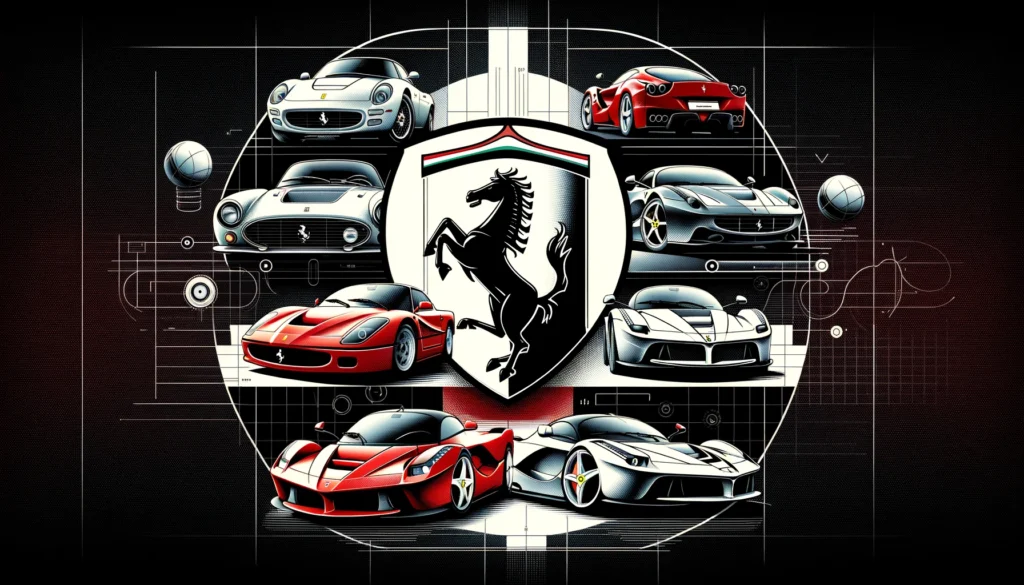
Introduction
Ferrari: a name that evokes images of speed, luxury, and automotive excellence. This iconic brand has not only defined the sports car genre but has also established itself as a symbol of prestige and high performance around the globe. In this detailed exploration of the astonishing story of excellence of Ferrari, we uncover the rich history of Ferrari, from its humble beginnings to its current status as a titan in both road and racing cars. Join us as we delve deep into the legacy of this legendary automaker.
The Birth of a Racing Icon (1929-1947)
Enzo Ferrari: A Passion for Racing
The story of Ferrari begins with its visionary founder, Enzo Ferrari, whose deep-rooted passion for racing set the foundation for a brand that would become synonymous with speed and precision. Enzo’s initial foray into the racing world as a driver for Alfa Romeo in the 1920s not only showcased his driving skills but also his understanding of racing mechanics, laying the groundwork for his future automotive endeavors.
The Formation of Scuderia Ferrari
In 1929, Enzo took a monumental step by establishing Scuderia Ferrari, an entity initially intended to sponsor amateur drivers. This team quickly evolved beyond its original purpose, becoming the official racing team representing Alfa Romeo. Scuderia Ferrari’s early years were formative, building a reputation in the racing community and proving the capabilities of its assembled team and machinery under the astute leadership of Enzo.
The Launch of the Ferrari Brand
The culmination of Enzo’s vision came in 1947, marking a pivotal moment in automotive history with the launch of the Ferrari brand. This era began with the production of the first car bearing the Ferrari name—the Ferrari 125 S. This vehicle was not just a product; it was a statement of Enzo’s ambition to create high-performance racing cars that embodied his passion for speed and innovation. The introduction of the 125 S set the stage for Ferrari’s future successes both on the track and in automotive design.
The 125 S: The Dawn of a Dynasty (1947)
Introduction of the Ferrari 125 S
The Ferrari 125 S was not merely the first car to bear the Ferrari name; it represented a bold declaration of Enzo Ferrari’s engineering prowess and his racing philosophy. This model was a testament to Enzo’s vision, embodying his dedication to superior performance and groundbreaking automotive design. The 125 S marked the beginning of what would become a legendary lineage in the world of racing cars.
Debut and Initial Challenges
Powered by a robust 1.5-liter V12 engine, the 125 S made its competitive debut at the Piacenza racing circuit. Despite advanced engineering and promise, the 125 S retired from its first race due to technical difficulties. This initial hiccup, however, was a crucial learning experience and showcased Ferrari’s resilience and commitment to overcoming challenges.
Victory and Legacy
Despite an early setback, the 125 S won in Rome weeks later, heralding Ferrari’s prolonged dominance in racing. This win proved significant, showcasing Ferrari’s power, speed, and relentless commitment to ongoing improvement and innovation. Rome’s victory was merely the start, predicting numerous future triumphs and laying the groundwork for a lasting racing dynasty.
Decade of Dominance: Ferrari in Motorsport (1950s)
Ferrari’s Formidable Entry into Formula One
The 1950s began Ferrari’s motorsport dominance, starting with an impactful debut in Formula One in 1950. Ferrari’s entrance into the premier class of single-seater racing marked them as a formidable competitor from the start. The team’s competitive spirit and engineering expertise soon drew widespread attention in the racing community. Their prowess set the foundation for a decade of exceptional performance, dominating the motorsport world.
Legendary Drivers and Unprecedented Victories
Legendary drivers Ascari and Fangio led Ferrari to numerous victories, showcasing both their skills and the cars’ design. Their performances became benchmarks in racing, symbolizing excellence and pushing Ferrari vehicles to their limits. Their success helped cement Ferrari’s global reputation, highlighting the brand’s superior engineering and performance capabilities.
Impact on Automotive Engineering and Design
The 1950s saw the creation of iconic models like the 375 F1, displaying Ferrari’s engineering skill and speed focus. This period established Ferrari’s racing dominance and expanded its impact across the broader automotive industry. Innovations during this decade established new benchmarks in vehicle performance and design, setting industry-wide standards. These advancements influenced many generations of vehicles, extending Ferrari’s influence well beyond just the racetrack.

Expanding Horizons: Road Cars and Brand Evolution (1960s)
Introduction to Luxury Road Cars
As Ferrari continued to excel on the racetrack, the 1960s marked a significant expansion into the production of road cars. This decade saw the birth of iconic models like the 250 GT, the 275, and the 365 California. These vehicles became symbols of luxury and performance, embodying Ferrari’s racing heritage and expert craftsmanship in designs suited for the road.
The Revolutionary Ferrari 246 Dino
The introduction of the mid-engined Ferrari 246 Dino represented a significant shift in Ferrari’s design philosophy. This model was aimed at making Ferrari’s renowned performance more accessible to the public. Its innovative design and more affordable pricing compared to Ferrari’s top-line models made it a pivotal addition to Ferrari’s lineup, bringing the thrill of racing performance into more hands.
Branding Evolution: The Prancing Horse Logo
In the 1960s, Ferrari introduced the prancing horse logo, rapidly becoming a symbol of exclusivity and prestige. This emblem enhanced Ferrari’s brand identity and cemented its status as a luxury and high-performance automotive icon. The introduction of the logo signaled a new branding era, aligning Ferrari’s image across competitive and public spheres. It helped unify Ferrari’s representation from racing circuits to urban avenues, embodying luxury and elite performance everywhere.
Facing Challenges: Economic Struggles and Recovery (1970s-1980s)
The oil crisis of the 1970s posed significant challenges for luxury car manufacturers like Ferrari. Economic downturns led to decreased demand for high-performance cars. However, Ferrari adapted by focusing on technological advancements and improving the efficiency of their vehicles. The 1980s heralded a period of recovery with the introduction of models like the Testarossa and the GTO. These cars featured innovative design and powerful engines, helping to revitalize the brand and affirm its market position amidst economic uncertainties.
Innovation and Expansion: The Modern Era (1990s-Present)
Pioneering Automotive Technology
Entering the modern era, Ferrari continued its astonishing story of excellence by pushing the boundaries of automotive technology and design. The 1990s and 2000s were marked by the introduction of groundbreaking models that set new standards in the car industry. Vehicles like the F50 and the Enzo emerged as embodiments of cutting-edge technology and aesthetic brilliance, showcasing Ferrari’s commitment to innovation.
Embracing Hybrid Technology
The progression into the late 2000s and beyond saw Ferrari taking significant steps towards environmental sustainability. The introduction of the LaFerrari, which incorporated hybrid technology, was a pivotal moment for the brand. This model was designed to enhance performance while significantly reducing environmental impact, marking Ferrari’s initial foray into a more sustainable approach to supercar manufacturing.
Expanding Beyond Automobiles
Today, Ferrari not only remains a leader in performance cars but has also embraced sustainability with plans to introduce more hybrid and electric models. The brand’s expansion into lifestyle segments through merchandise and branding ventures has further solidified its status as a cultural icon. This diversification has helped Ferrari maintain its prestigious reputation and connect with a broader audience, extending its influence beyond the automotive industry.
Conclusion
The story of Ferrari is one of passion, innovation, and resilience. From the race tracks of Maranello to the streets of major cities around the world, Ferrari has maintained its status as a beacon of luxury and high performance. As we have explored the various facets of Ferrari’s astonishing story of excellence, it becomes clear that the spirit of Enzo Ferrari still drives the brand towards new horizons. Ferrari’s legacy is not just built on its past achievements but on its continuous pursuit of the future. The prancing horse continues to gallop forward, promising more innovation, more speed, and more excitement for automotive enthusiasts around the globe.
This comprehensive look at Ferrari’s journey illustrates the power of visionary leadership and the enduring appeal of luxury and speed. It’s a testament to the brand’s resilience and its relentless pursuit of excellence, making Ferrari not just a car manufacturer but a legend carved in the annals of automotive history.



